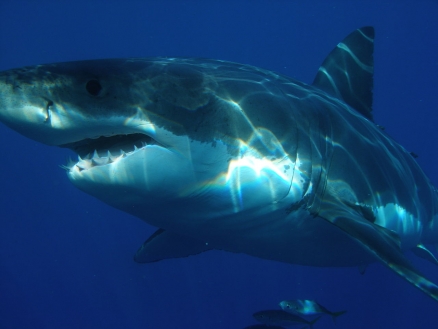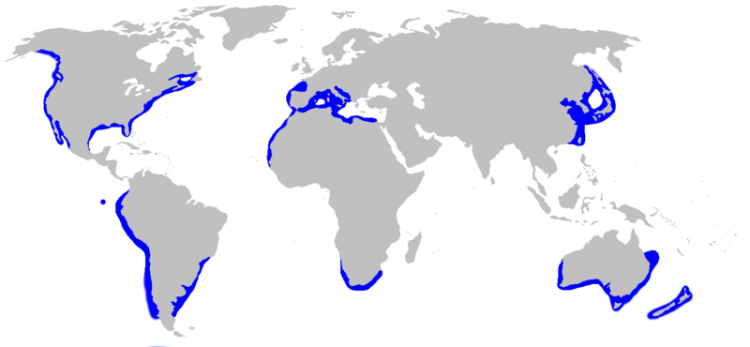Great White Shark
Thegreat white shark or white sharkCarcharodon carchariasis one offive species in the familyLamnidae. The remaining members of Lamnidae being the shortfin mako Isurus oxyrinchus, longfin mako Isurus paucus, salmon shark Lamna ditropis, and the porbeagle shark Lamna nasus. White sharks arethought to have evolved from the extinct Carcharodon hubbelli, a species of shark thatpersisted in the late Miocene, 6-8 mya. Due to its attention in the media, thewhite sharkhas beenvillianized as is most evident in the hit movie Jaws (1975). In reality, thewhite sharkis simply abiding by the rules of nature and fulfilling its position at the top ofthe food chain.
|
Conservation Status |
|
Scientific Classification Kingdom: Animalia |
Contents
Physical Description
The white shark is one of, if not the most, well-known and easily recognizable fishes found on earth. The lateral and dorsal regions of the body are light to dark grey. The ventral region of the body from snout to tail is pearl white. The snout is relatively long, pointed, and contains numerous electroreceptive pores in the skin,termed ampullae of Lorenzini. The teethare triangular andserrated, which function like a steak-knife and can easily tear through the toughest of hides.The eyes are dark black andhave the ability ofrolling back to protect the eyes whenpursuing prey that are well-equipped to fight back like seals. The caudal fin is heterocercal and lunate andthe caudalpeduncle has a prominent keel, which reduces drag.Five longgill slitslie anterior to thelargepectoral fins thatfunction in generating lift. The pectoral fins also havecharicteristic black markings on the ventral side where the fins come to a point.The pelvic fins lie on the ventroposterior portion of the body.The first dorsal fin is large and rectangular.Both the second dorsalandanal fins are tiny compared to the other fins.The longest confirmed white shark measured 5.944 meters long and was caught in 1984 off the coast of Western Australia. White sharks can weighup to3,000+ Kilograms. White sharks are late-maturing and long-lived sharks that are estimated to live 40-60 years in the wild.
Reproduction
The white shark reproductive mode is ovoviviparous in which the developingembryos are nourished by eggs produced by the females ovaries (oophagy). Male white sharks are estimated to reach sexual maturity at about3.5-3.8 meters in length and 7-9 years old. Femalesare believed to reach sexual maturity at 4.5-5.0 meters in length and 12-17 years of age. Gestation periodlasts 12-18 months.The breeding intervals (time between breeding events) is 2-3 years.Females give birth to litters of2-17 pups, whichat birth, arealready 1.0-1.5 meters in length.Juvenile white sharksreside near the coast and feedmainly on other fishes.
Distribution & Movements
|
Chris_huh - Compagno, Leonard; Dando, Marc & Fowler, Sarah (2005). Sharks of the World. Collins Field Guides. ISBN 0-00-713610-2. |
Distributed worldwide, withexceptionof polar seas, and can be foundin the warm to temperate waters oftheIndian, Atlantic, and Pacific Oceans. The largest populations of white sharks occur along the coasts of South Africa, Australia,central California, and the Atlantic coast of North America.White sharks are bothcoastal and oceanic speciesas they can be found inshore andare alsoknownfor small-scale migrations along coastlines and large-scalemigrationsspanning entire oceans. Common migratory routes include adistance of 3,800kilometers(2,361 miles) between the coasts of California and Hawaiiin the Northern Pacific Ocean. Migratory white sharks also cross the Indian Ocean from South Africa to Australia, a distanceof 22,000 kilometers (13,670 miles). Other individuals have alsobeen documented migratingfrom Australia to New Zealand.
Habitat
The white shark is both a coastal and oceanic species, which can be found from 0-1,300 meters deep. Inshore white sharkscan befound in the rocky reefs or shallow bays of coastal regions.Migratory white sharkscan beobserved traversing continental shelvesandnavigating the open ocean. Habitat use varies seasonally and depends on temperature, food availability, gender, and reproduction.
Food & Feeding Habits
Lamnid sharks have a heat conservation mechanismtermed counter-current exchange system. Heat generated by muscle contractions isretained byjuxtaposedcapillaries thatrun counter-currentto each other and the heat diffuses down its concentration gradient.This givesC. carchariasand other lamnid sharksthe ability ofsustaining elevated levels of activity when in cooler waters. White sharks are mega-predatory oceanic fishes that will feed on marine mammals (Cetaceans and Pinnipeds), seabirds,sea turtles, crustaceans,cephalopods (squid and octopus), and fishes including other sharks. When closing in on a prey, the white shark lifts the upper jaw and drops the lower jaw to maximize gape. When prey is captured in the mouth, the upper jaw is rotated forward and down and the lower jaw is lifted forward and up, therebyarticulatingthe jaws to actuallythrust the jaws outward towards the prey.Prime conditions for seal hunting include cloud cover and turbidwaters, which gives white sharks theelement of surprise, key for capturing highlyagile prey. White sharks use vision to locate and identify potential prey.The cryptic coloration of the white shark actsas counter-shading, allowing the shark to go undetected by prey when viewed from above.Large white sharkscan be foundhunting near islands where marine mammals like seals congregate.The most infamous feeding strategy of white sharks is "breaching", in which white sharks attack prey at the surface from below,propelling themselvesmany meters above waters surface.The high blubber contentin sealsmakes themrich inenergy when consumed. White sharks also have a low oxygen consumption raterelative to other large fishes, thus,a diet consisting of high energy preyand a low oxygen consumption rate allow white sharks toendure extended periods of time without food.
Predation
White sharks have low natural mortality rates as humans andorcas Orcinus orcaare their only natural predators. White sharks are routinely caught as bycatch from commercial fishermen, due to entanglement in fishing nets that aretargeting other species of fishes. Unless freed from entanglement, the white shark willperish as they need to continuously swim to respire. Tuna farm owners have also been known todispatch white sharks that have endangered the stock offarm raised tuna.
Economic Importance for Humans
White sharks caught as bycatch are utilized for consumption from their fins and meat. While the fins are not considered high quality by the Chinese market, commercial fishermen will stilltake the fins of any large shark, regardless of species.White sharks have also beenharvested for their jaws and teeth to be utilized as novelty items by collectors. White shark jaws have sold for thousands of dollars (depending on size) due to a high demand from private collectors. White shark teeth have been sold for hundreds of dollars (also depending on size). Cage divingwith white sharks hasbecome a popular tourist attractionparticularly inSouth Africa,Australia, and California wherenumerous cage divingvessels luretourists seeking a thrill.Steven Spielberg's1970's hit movie JAWS starred aman-eating white shark off the coast of theNortheastern United Statesandhas grossed $430,000,000.00 USD since its release in theatres.
Threats & Conservation Status
The first country to protect the white shark was South Africa in 1991.The white shark was listed as Protected by the South African fisheries legislation, making it illegal to capture or kill white sharks in South Africa. The Australian federal government's Environmental Protection and Biodiversity Conservation Act 1999 lists the white shark as Vulnerable. The white shark was alsolisted at Vulnerable in 2009 by the IUCN Red List of Threatened Species.The Convention on International Trade in Endangered Species of Wild Fauna and Flora (CITES) lists the white shark under Appendix II, meaning that the species is vulnerable to endangerment.
Further Reading
- Compagno, Leonard, Marc Dando, & Sarah Fowler. 2005. Sharks of the World. Princeton University Press, Princeton and Oxford.
- Department of Sustainability, Environment, Water, Population and Communities (2013).Carcharodon carcharias in Species Profile and Threats Database, Department of Sustainability, Environment, Water, Population and Communities, Canberra. Available from: http://www.environment.gov.au/sprat.
- Duffy, Clinton. 2004. International trade in white shark Carcharodon carcharias products from New Zealand. Shark News: Newsletter of the IUCN shark specialist group.
- Ehret, Dana J., Bruce J. Macfadden, Douglas S. Jones, Thomas J. Devries, David A. Foster, & Rodolfo Salas-Gismondi. 2012. Origin of the white shark Carcharodon (Lamniformes: Lamnidae) bason on recalibration of the Upper Neogene Pisco Formation of Peru. Palaeontology Vol. 55: pg. 1139.
- Fergusson, I., Compagno, L.J.V. & Marks, M. 2009. Carcharodon carcharias. In IUCN 2012. IUCN Red List of Threatened Species. Version 2012.2. <www.iucnredlist.org>.
- Johnson, Ryan. 2003. The behavioral ecology of the white shark (Carcharodon carcharias) at Dyer Island. Faculty of Natural and Agricultural Sciences, University of Pretoria.
- Spielberg, Steven. 1975. JAWS. http://www.imdb.com/title/tt0073195/.


